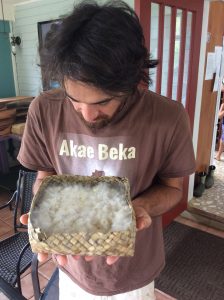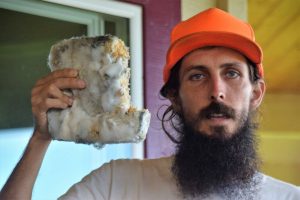Tree wounds and scars in trees can be healed with KNF Microbes made into a paste with seawater and bound with oatmeal so it sticks to the bark.
Master Cho talks about this solution in regards to sunburn in the following video (starting at 7 minutes 40 seconds), but the solution is the same for healing wounds and scars.
- drake answered 7 years ago
- last active 7 years ago
Yes, it is still important to toast coral sand. The reason for toasting to a light brown like a perfectly done marshmallow is twofold:
- Remove the moisture from the calcarb so the vinegar will penetrate more easily and thoroughly dissolve all the calcium out into solution
- Coral is full of tiny bits of organic matter, so to cook them out so that the mixture will not rot later during storage.
I recommend doing this on a slightly higher heat that has been traditionally taught, around a low medium so that it will take about 15 minutes with constant stirring as not to burn. Try not to burn the coral and turn it black as that chemically destroys the calcium and starts to carbonize it. Sort of like the marshmallow, it takes keen effort and the right heat to cook it just perfectly!
Good luck, and Long live the natural farmer!
- drake answered 7 years ago
I think your plan of using the licorice as a drink and restarting may be the best way to fully get all 5 extractions out and in the correct concentrations. It’s a bummer when these break, I’ve had it happen to me too.
What I end up doing is I have so much KNF Medicine going that I just keep charging forward. There are several batches all mixing into their respective pour off containers. Each time I pour off, I put a tick mark on the jar and refill as appropriate, but the pour off container I have is a 5 gallon bucket for each one, so it can handle a lot of extractions.
- drake answered 7 years ago
The Level 2 competency course is best in person. In fact that is the only real way to get this course. The Level 1 course that I taught at Hawaiian Sanctuary was so comprehensive that it covers almost all the material that would be covered in Level 2 minus the hands on portions. The reason for this is that they wanted a 2 hour class for 6 sessions, so I just went for it giving everything I had to the class. I am however always refining and improving the course, so just like watching Master Cho, there is always more to be gleaned even from the most basic course.
I am however in the process of releasing footage from the Level 2 Course that I taught here at the knfFarm in Onomea. I was reluctant to just give this away as I open source most everything and I need to recoup my costs so I can keep doing what I do, but alas, the world really needs this, and for some reason I am firmly opposed to operating quid pro quo.
However if you would like to thank me online (and dollars are the best way to do that) you can make a financial contribution to me personally through my website (just change the quantity to something appropriate) or paypal = drakew@gmail.com
- drake answered 7 years ago
Yes, the oven will work well. 180 for 2 hours seems appropriate to get rid of the moisture. I think it will have to be a bit warmer to toast out the organic material. Seems to me more like 250 for 2 hours, but this is an energy thing. Don’t want to burn them, and I don’t have any empirical evidence on this as I always use the pan method, but I typically use a low medium heat, which is a bit more than what the textbook calls for, but we did this in Korea under Master Cho’s watch and he nodded in approval of the higher heat, quicker cook time.
When baking in the oven, crushing is not necessary unless it makes sense. When cooking in the pan, crushing is mandatory trying to get the shells 1-2mm in size. I do not recommend powdering them.
- drake answered 7 years ago
This is actually the hardest part of KNF to explain. This past year I went to 3 trainings specifically on this topic, and I finally get it. So, I have only done one lecture series explaining this in english that was recorded, but I have yet to process the video and put it online. Some of my older work attempted to explain nutrient cycle, but it has to be updated with my new and correct understanding to fully answer this question.
Will updated this question with a new answer when I finally get around to creating the western mindset english material!
- drake answered 7 years ago
In KNF it has been found that worm castings are an almost essential part of waking up the dormant KNF Microbes. Worm castings are full of vital humic and fulvic acids which signal to the indigenous micro organisms that it is time to wake up and go to work. In nature this would occur in a rich forest environment where the fungus is happy to hatch and live a very comfortable life, but for us, we are sort of “hacking” nature a bit by tricking the microbes into thinking they are in the forest, when in reality, they are in our cultivated fields.
Humic and fulvic acids as well as worm castings are naturally found in a humus layer, yet we want to kick start that process, so we can make a tea of concentrated KNF Microbes and in this include KNF Food, KNF Cleanser, KNF Medicine as well as worm castings and actively aerate this solution for 24-36 hours to grow the populations to immense numbers, then spray or drench this on the area we want to treat, and the soil responds by coming to life with all the essential ingredients of a naturally healthy system.
- drake answered 7 years ago
Whitish mold will grow on all kinds of things. I have forgotten rice in a rice cooker for a week and come back to a nice bloom! Is this IMO, yes, it is indigenous micro organisms!
Is this the KNF Microbes we are looking for to enhance our soil? NO. These microbes will do little if anything to enhance our soil and will be a waste of time to grow up to immense populations using a bokashi method.
What we are looking for in Korean Natural Farming are beneficial soil microbes. To get these, we must put a box with freshly cooked rice (or other starch material such as potato, but rice has a plethora more reasons why it is used as a media) into the forest in a container that gives it 1/3 airspace to create a perfect microcosm for microbial growth.
When the soil below the box is disturbed as we sweep away the leaf litter and dig slightly into the dirt, this is like hurricane Katrina for the microbes. They are destroyed, but this nice new rice is like FEMA coming in (although as a libertarian I do not believe in this type of activity, I am merely, albeit poorly, illustrating the point) with disaster relief supplies, so all the poor microbes flock to the new rice box to get relief. This in turn captures us a fractal of the forest microbiome and some of the most well adapted and well adjusted to working with the indigenous soil types around.
The leaf litter is also placed back on top of the box while it is incubating to thus create a cocoon type environment that really gives these indigenous soil microbes the best ability to colonize the rice.
These are the microbes you are looking for!
A good collection will be a thick mass of microbes that hold the rice together in a tempe like fashion. The top may have white wisps that look like spider webs or even better white cotton ball looking growths. There should be a minimum of tie-dye looking microbes as these indicate anaerobic microbes, but use the 80/20 rule where 80% should be good, and consider that an excellent collection.
You can see a great collection in this short clip:
- drake answered 7 years ago
2/3 is the sweet spot in KNF for various reasons. One of the main reasons is 2/3 is a close approximation to the golden ratio which is the key to all life as we know it. The closer you get to this ratio, the more easily energy will emerge out of the infinite space which is essential for fermentation. For more information on this you can study Pythagoras and the concept of the square root of the unit square.
If you can’t hit 2/3, don’t worry. Yes, the correct solution would be to find an appropriate container, but let’s get real, if it ain’t easy, we ain’t gonna do it. And since you are already done with it, roll with it. Learn from this experience and maybe next time get closer to mastering KNF.
KNF Medicine and KNF Microbes are not necessary for KNF Fuel. They are an optional side note in the text and actually modify the end product so that you will lose the fats and oils that float on the surface of KNF Fuel made without them.
- drake answered 7 years ago
Sharing a picture will really help to diagnose this.
Also, describing the smell is crucial. If it smells like dead bodies, it is probably too long. If it smells kinds sweet or sour like sour dough, you are most likely good.
Here is a tank we did in a 55 gallon drum that doesn’t have nice bubble rings, but it is good to go based on smell. The reason for no bubble rings perhaps is caused by all the crap that floated up and this metal 55 gallon drum seems to slag off material/rust every time I use them, so not a bad thing. Just not picture perfect.
- drake answered 7 years ago

